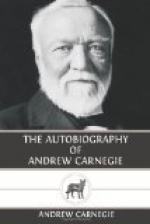I have tried always to hold fast to this important fact. It has been with me a cardinal doctrine that I could manage my own capital better than any other person, much better than any board of directors. The losses men encounter during a business life which seriously embarrass them are rarely in their own business, but in enterprises of which the investor is not master. My advice to young men would be not only to concentrate their whole time and attention on the one business in life in which they engage, but to put every dollar of their capital into it. If there be any business that will not bear extension, the true policy is to invest the surplus in first-class securities which will yield a moderate but certain revenue if some other growing business cannot be found. As for myself my decision was taken early. I would concentrate upon the manufacture of iron and steel and be master in that.
My visits to Britain gave me excellent opportunities to renew and make acquaintance with those prominent in the iron and steel business—Bessemer in the front, Sir Lothian Bell, Sir Bernard Samuelson, Sir Windsor Richards, Edward Martin, Bingley, Evans, and the whole host of captains in that industry. My election to the council, and finally to the presidency of the British Iron and Steel Institute soon followed, I being the first president who was not a British subject. That honor was highly appreciated, although at first declined, because I feared that I could not give sufficient time to its duties, owing to my residence in America.
As we had been compelled to engage in the manufacture of wrought-iron in order to make bridges and other structures, so now we thought it desirable to manufacture our own pig iron. And this led to the erection of the Lucy Furnace in the year 1870—a venture which would have been postponed had we fully appreciated its magnitude. We heard from time to time the ominous predictions made by our older brethren in the manufacturing business with regard to the rapid growth and extension of our young concern, but we were not deterred. We thought we had sufficient capital and credit to justify the building of one blast furnace.
The estimates made of its cost, however, did not cover more than half the expenditure. It was an experiment with us. Mr. Kloman knew nothing about blast-furnace operations. But even without exact knowledge no serious blunder was made. The yield of the Lucy Furnace (named after my bright sister-in-law) exceeded our most sanguine expectations and the then unprecedented output of a hundred tons per day was made from one blast furnace, for one week—an output that the world had never heard of before. We held the record and many visitors came to marvel at the marvel.




